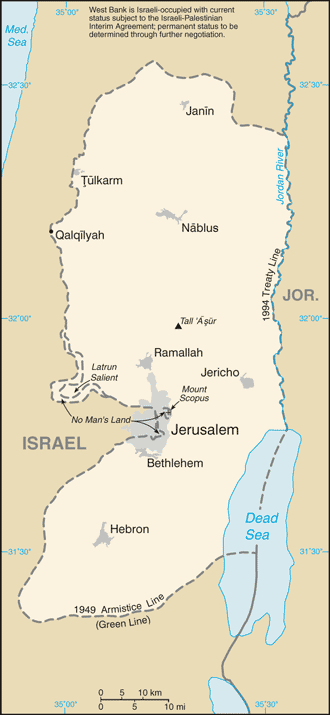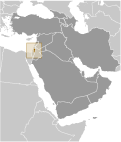
|
|
Advertisements:
EconomyEconomy - overview
The West Bank - the larger of the two areas comprising the Palestinian territories - has experienced a relatively high single-digit economic growth rate since 2008, but this rate has been sustained by inflows of donor aid rather than private sector economic activity. After suffering an almost decade-long downturn following the start of the second intifada in 2000, overall standard-of-living measures have recovered to the levels seen in the late 1990s. Despite the Palestinian Authority's (PA) largely successful implementation of economic and security reforms and the easing of some movement and access restrictions by the Israeli Government in 2010, Israeli closure policies continue to disrupt labor and trade flows, industrial capacity, and basic commerce, eroding the productive capacity of the West Bank economy. Since mid-2007 the PA under President Mahmoud ABBAS and Prime Minister Salam FAYYAD has depended on more than $3 billion in direct foreign donor assistance to the PA's budget. The biggest impediments to economic improvements in the West Bank remain Palestinians' lack of access to land and resources in Israeli-controlled areas, import and export restrictions, and a high-cost capital structure. Absent robust private sector growth, the PA will continue to rely heavily on donor aid for its budgetary needs. Gdp (purchasing power parity) World Ranking: 145
$12.79 billion (2009 est.)
$11.95 billion (2008) Note Includes Gaza Strip Gdp (official exchange rate)
$6.641 billion
Note Includes Gaza Strip (2008 est.) Gdp - real growth rate World Ranking: 31
7% (2009 est.)
2.3% (2008 est.) Note Includes Gaza Strip Gdp - per capita (ppp) World Ranking: 172
$2,900 (2008 est.)
Note Includes Gaza Strip Gdp - composition by sector
Agriculture 3.7%
Industry 13.6% Services 82.7% (includes Gaza Strip) (2011 est.) Labor force World Ranking: 150
745,600 (2010)
Labor force - by occupation
Agriculture 16.1%
Industry 28.4% Services 55.5% (2010 est.) Unemployment rate World Ranking: 172
23.5% (2011 est.)
16.5% (2010 est.) Population below poverty line
18.3% (2010 est.)
Household income or consumption by percentage share
Lowest 10% 3.2%
Highest 10% 28.2% Budget
Revenues $2.15 billion
Expenditures $3.23 billion Note Palestinian Authority, includes Gaza Strip (2011 est.) Taxes and other revenues World Ranking: 79
32.4% of GDP (2011 est.)
Budget surplus (+) or deficit (-) World Ranking: 209
-16.3% of GDP (2011 est.)
Inflation rate (consumer prices) World Ranking: 125
5% (2011 est.)
6% (2010 est.) Note Includes Gaza Strip Commercial bank prime lending rate World Ranking: 130
7.3% (31 December 2011 est.)
7.3% (31 December 2010 est.) Stock of narrow money World Ranking: 167
$379.8 million (31 December 2011 est.) $232.6 million (31 December 2010 est.) Stock of broad money World Ranking: 116
$6.674 billion (31 December 2011 est.) $6.674 billion (31 December 2010 est.) Stock of domestic credit World Ranking: 147
$1.503 billion (31 December 2011 est.) $1.353 billion (31 December 2010 est.) Market value of publicly traded shares World Ranking: 94
$2.532 billion (31 December 2011) $2.45 billion (31 December 2010) $2.375 billion (31 December 2009) Agriculture - products
Olives, citrus fruit, vegetables; beef, dairy products Industries
Small-scale manufacturing, quarrying, textiles, soap, olive-wood carvings, and mother-of-pearl souvenirs Industrial production growth rate
NA%
Electricity - production World Ranking: 214
0 kWh
Note Electricity in the West Bank is imported mostly from Israel (2011 est.) Electricity - consumption World Ranking: 160
550 million kWh (2011 est.)
Electricity - exports
0 kWh (2011)
Electricity - imports
550 million kWh (2011 est.)
Oil - production World Ranking: 144
0 bbl/day
Note Data include the Gaza Strip (2010 est.) Oil - consumption World Ranking: 122
24,000 bbl/day
Note Data include the Gaza Strip (2010 est.) Oil - exports World Ranking: 207
0 bbl/day
Note Data include the Gaza Strip (2009 est.) Oil - imports World Ranking: 108
22,110 bbl/day
Note Data include the Gaza Strip (2009 est.) Oil - proved reserves World Ranking: 206
0 bbl
Note Data include the Gaza Strip (1 January 2009 est.) Natural gas - production World Ranking: 142
0 cu m (2009 est.)
Natural gas - consumption World Ranking: 143
0 cu m (2009 est.)
Natural gas - exports World Ranking: 205
0 cu m (2009 est.)
Natural gas - imports World Ranking: 143
0 cu m (2009 est.)
Natural gas - proved reserves World Ranking: 141
0 cu m (1 January 2011 est.)
Exports World Ranking: 169
$518 million (2009)
$529 million (2008) Note Includes Gaza Strip Exports - commodities
Stone, olives, fruit, vegetables, limestone Imports World Ranking: 137
$3.601 billion (2009)
$3.772 billion (2008) Note Data include the Gaza Strip Imports - commodities
Food, consumer goods, construction materials, petroleum, chemicals Debt - external World Ranking: 155
$1.04 billion (2010 est.)
$1.3 billion (2007 est.) Note Data include the Gaza Strip Exchange rates
New Israeli shekels (ILS) per US dollar - 3.5781 (2011)3.73 (2010) 3.932 (2009) 3.588 (2008) 4.14 (2007) Fiscal year
Calendar year
Comments
Add a new comment: |
Advertisement
Members area
West Bank:

GPS points from West Bank
|
||||||||

 The September 1993 Israel-PLO Declaration of Principles on Interim Self-Government Arrangements provided for a transitional period of Palestinian self-rule in the West Bank and the Gaza Strip. Under a series of agreements signed between May 1994 and September 1999, Israel transferred to the Palestinian Authority (PA) security and civilian responsibility for many Palestinian-populated areas of the West Bank and Gaza Strip. Negotiations to determine the permanent status of the West Bank and Gaza Strip stalled following the outbreak of an intifada in September 2000. In April 2003, the Quartet (US, EU, UN, and Russia) presented a roadmap to a final settlement of the conflict by 2005 based on reciprocal steps by the two parties leading to two states, Israel and a democratic Palestine. Following Palestinian leader Yasir ARAFAT's death in late 2004, Mahmud ABBAS was elected PA president in January 2005. A month later, Israel and the PA agreed to the Sharm el-Sheikh Commitments in an effort to move the peace process forward. In September 2005, Israel unilaterally withdrew all of its settlers and soldiers and dismantled its military facilities in the Gaza Strip and withdrew settlers and redeployed soldiers from four small northern West Bank settlements. Nonetheless, Israel still controls maritime, airspace, and other access to the Gaza Strip. In January 2006, the Islamic Resistance Movement, HAMAS, won control of the Palestinian Legislative Council (PLC). HAMAS took control of the PA government in March 2006, but President ABBAS had little success negotiating with HAMAS to present a political platform acceptable to the international community so as to lift economic sanctions on Palestinians. Violent clashes between Fatah and HAMAS supporters in the Gaza Strip in 2006 and early 2007 resulted in numerous Palestinian deaths and injuries. In February 2007, ABBAS and HAMAS Political Bureau Chief Khalid MISHAL signed the Mecca Agreement in Saudi Arabia that resulted in the formation of a Palestinian National Unity Government (NUG) headed by HAMAS member Ismail HANIYA. However, fighting continued in the Gaza Strip, and in June 2007, HAMAS militants succeeded in a violent takeover of all military and governmental institutions in the Gaza Strip. ABBAS that same month dismissed the NUG and through a series of presidential decrees formed a PA government in the West Bank led by independent Salam FAYYAD. Fatah and HAMAS in May 2011, under the auspices of Egyptian-sponsored reconciliation negotiations, agreed to reunify the Palestinian territories, but the factions have struggled to finalize details on governing and security structures. The status quo remains with HAMAS in control of the Gaza Strip and ABBAS and the Fatah-dominated PA governing the West Bank. FAYYAD and his PA government continue to implement a series of security and economic reforms to improve conditions in the West Bank. ABBAS, who on behalf of the Palestinians in September submitted a UN membership application, has said he will not resume negotiations with current Israeli Prime Minister Binyamin NETANYAHU until Israel halts all settlement activity in the West Bank and East Jerusalem.
The September 1993 Israel-PLO Declaration of Principles on Interim Self-Government Arrangements provided for a transitional period of Palestinian self-rule in the West Bank and the Gaza Strip. Under a series of agreements signed between May 1994 and September 1999, Israel transferred to the Palestinian Authority (PA) security and civilian responsibility for many Palestinian-populated areas of the West Bank and Gaza Strip. Negotiations to determine the permanent status of the West Bank and Gaza Strip stalled following the outbreak of an intifada in September 2000. In April 2003, the Quartet (US, EU, UN, and Russia) presented a roadmap to a final settlement of the conflict by 2005 based on reciprocal steps by the two parties leading to two states, Israel and a democratic Palestine. Following Palestinian leader Yasir ARAFAT's death in late 2004, Mahmud ABBAS was elected PA president in January 2005. A month later, Israel and the PA agreed to the Sharm el-Sheikh Commitments in an effort to move the peace process forward. In September 2005, Israel unilaterally withdrew all of its settlers and soldiers and dismantled its military facilities in the Gaza Strip and withdrew settlers and redeployed soldiers from four small northern West Bank settlements. Nonetheless, Israel still controls maritime, airspace, and other access to the Gaza Strip. In January 2006, the Islamic Resistance Movement, HAMAS, won control of the Palestinian Legislative Council (PLC). HAMAS took control of the PA government in March 2006, but President ABBAS had little success negotiating with HAMAS to present a political platform acceptable to the international community so as to lift economic sanctions on Palestinians. Violent clashes between Fatah and HAMAS supporters in the Gaza Strip in 2006 and early 2007 resulted in numerous Palestinian deaths and injuries. In February 2007, ABBAS and HAMAS Political Bureau Chief Khalid MISHAL signed the Mecca Agreement in Saudi Arabia that resulted in the formation of a Palestinian National Unity Government (NUG) headed by HAMAS member Ismail HANIYA. However, fighting continued in the Gaza Strip, and in June 2007, HAMAS militants succeeded in a violent takeover of all military and governmental institutions in the Gaza Strip. ABBAS that same month dismissed the NUG and through a series of presidential decrees formed a PA government in the West Bank led by independent Salam FAYYAD. Fatah and HAMAS in May 2011, under the auspices of Egyptian-sponsored reconciliation negotiations, agreed to reunify the Palestinian territories, but the factions have struggled to finalize details on governing and security structures. The status quo remains with HAMAS in control of the Gaza Strip and ABBAS and the Fatah-dominated PA governing the West Bank. FAYYAD and his PA government continue to implement a series of security and economic reforms to improve conditions in the West Bank. ABBAS, who on behalf of the Palestinians in September submitted a UN membership application, has said he will not resume negotiations with current Israeli Prime Minister Binyamin NETANYAHU until Israel halts all settlement activity in the West Bank and East Jerusalem.